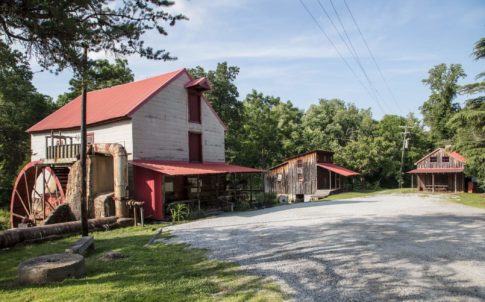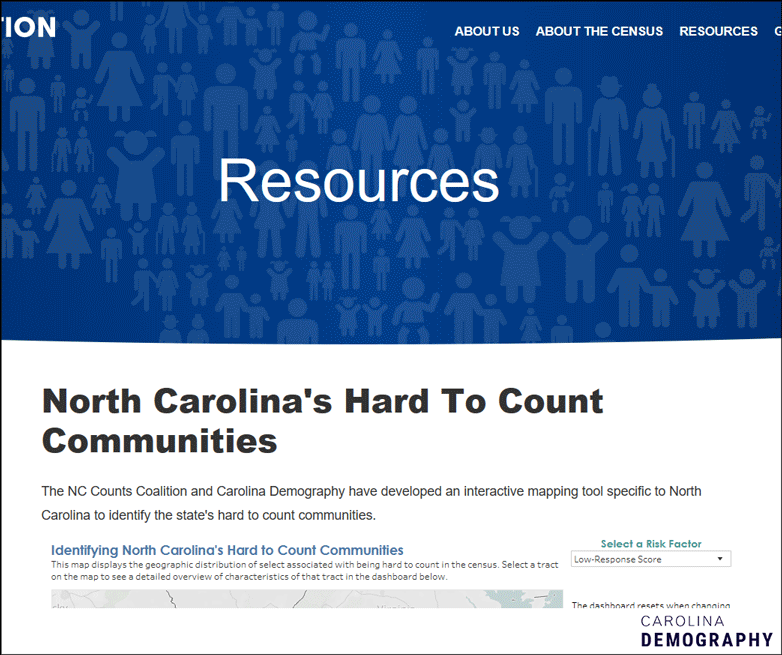Census 2020: Everything you need to know about North Carolina’s hard-to-count communities

A complete and accurate census count is incredibly important. The census shapes how billions of dollars in federal funding are distributed, how congressional seats are apportioned, and how communities plan for their future residents.
But certain populations have historically been undercounted in the census, due to a variety of factors. Undercounting these communities skews the census data that’s used to ensure fair political representation and support community planning.
To help North Carolina achieve a complete and accurate census count, Carolina Demography worked with the NC Counts Coalition to create a map that identifies communities across the state that are most at-risk of being undercounted in the 2020 Census.

Based on low-response scores and 2010 response rates from the U.S. Census Bureau’s 2018 Planning Database and the most up-to-date community characteristics from the U.S. Census Bureau’s 2017 5-Year American Community Survey, the tool also provides reasons why certain populations may be hard to reach or count.
We sat down with Rebecca Tippett, the Director of Carolina Demography, and Stacey Carless, Executive Director of the NC Counts Coalition, to learn more about making a map to examine North Carolina’s hard-to-count populations.
First, we should start off with the obvious: Why is the Census important for policymakers and researchers?
Rebecca Tippett: When we talk about the importance of the Census, we often talk about power and money. We use the Census counts to distribute political power and allocate funding for everything from highway spending to programs like Medicare and Head Start.
But the Census is more than just that. It is the backbone of virtually every data product researchers, governments, and businesses use to understand who we are, how we’ve changed, and what this might mean for the future. It’s also the most democratic and inclusive activity we do as a country. This once-a-decade count is the only source of basic demographic data on all individuals living in the United States.
Why is an accurate Census count important for North Carolina?
Stacey Carless: The Census directly affects the allocation of $16.3 billion annually in federal resources to North Carolina. Additionally, it provides key decision-makers with the information they need to ensure that government resources are directed strategically to the state’s communities. Also, the Census ensures that communities are appropriately represented in the statehouse and in Congress. With an accurate 2020 Census count, North Carolina is projected to gain a seat in the House of Representatives, increasing its representation from 13 to 14 representatives.
Why is it important to understand the populations that might be undercounted in the Census?
Rebecca Tippett: The term most commonly used by Census experts is “differential undercount,” which just means that not all populations are equally likely to be counted in the Census. Some groups—like college students or people who own two homes—are more likely to be counted more than once, while other groups—like young children or people who have recently moved—are less likely to be counted at all.
Communities only have one shot to count all of their residents. If a community is undercounted, they will have lower quality data and receive less than their fair share of political representation and funding for the next decade.
Why are communities undercounted?
There are four main reasons why a population might be hard to count:
What groups are traditionally harder to count?
Rebecca Tippett: Hard-to-count communities include children under age 6, renters, and American Indian, Hispanic, and Black households. Changes to the 2020 Census – such as the shift to primarily online data collection and the proposal to add a citizenship question may create new risks of undercount among additional groups.
Why did you commission the map and what were you hoping to learn?
Stacey Carless: We serve as a “go-to” resource for 2020 Census planning in North Carolina. Stakeholders and partners were asking for user-friendly maps to better target outreach to hard to count populations. There was a need for a NC specific resources and we wanted to develop it. Also, for our statewide plan, we needed more information on hard-to-count communities in North Carolina to determine where we will place our resources and target our outreach efforts.
How did you make the map that identifies communities across North Carolina that might be hard to count in the upcoming census?
Rebecca Tippett: We used Tableau Public with some expert guidance from the Davis Library Research Hub at UNC. We relied on data from multiple state and federal resources, including:
We then calculated distances from the middle of each census tract to the nearest library branch location in ArcGIS. All other data cleaning and evaluation was done using Stata.
What did you learn that surprised you?
Rebecca Tippett: A few things. First, the risk of an undercount is not an urban or rural phenomenon. Hard-to-count communities are spread across the state.
And many of our hardest-to-count communities are military communities. Cumberland County, home of Fort Bragg, and Onslow County, where Camp Lejeune is located, have multiple tracts at high risk of being undercounted in the 2020 Census.
But based on low-response rates—the predicted share of households who will not self-respond to the 2020 Census—Robeson County is the hardest-to-count county in North Carolina. Seventy-two percent of Robeson residents live in a census tract that is predicted to be among the hardest to count in 2020.
How does NC Counts plan to use the map?
Stacey Carless: To better target our outreach efforts and to provide it to the public for better understanding of hard-to-count communities in NC.
If I wanted to use the map to see my own community, how do I learn what census tract I live in?
Rebecca Tippett: You can use the Census Tract Street Locater tool from the U.S. Census Bureau.
Need help understanding population change and its impacts on your community or business? Carolina Demography offers demographic research tailored to your needs.
Contact us today for a free initial consultation.
Contact UsCategories: Carolina Demographics, Census 2020, NC in Focus
Tags: 2020 census, American Community Survey, U.S. Census Bureau

The Center for Women’s Health Research (CWHR) at the University of North Carolina School of Medicine released the 12th edition of our North Carolina Women’s Health Report Card on May 9, 2022. This document is a progress report on the…

Dr. Krista Perreira is a health economist who studies disparities in health, education, and economic well-being. In collaboration with the Urban Institute, she recently co-led a study funded by the Kate B. Reynolds Foundation to study barriers to access to…

Our material helped the NC Local News Lab Fund better understand and then prioritize their funding to better serve existing and future grant recipients in North Carolina. The North Carolina Local News Lab Fund was established in 2017 to strengthen…
Your support is critical to our mission of measuring, understanding, and predicting population change and its impact. Donate to Carolina Demography today.